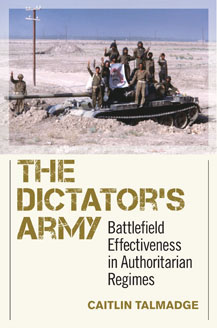
Caitlin Talmadge is assistant professor of political science and international affairs at the George Washington University, where she is also a member of the Institute for Security and Conflict Studies. She is a graduate of Harvard (A.B., summa cum laude) and the Massachusetts Institute of Technology (Ph.D.)
An excerpt from her book The Dictator's Army
Reprinted with permission by Cornell University Press, 2015: pp. 1–4.
IF THE BASIC ACTIVITIES that produce success on the modern battlefield are well known, why don't all states perform them?1 Why do some states successfully convert their national assets into operational- and tactical- level fighting power in war, whereas others fail even when they have the economic, demographic, and technological endowments needed to succeed?
This book proposes and tests an answer to these questions, one that focuses on the organizational practices that militaries adopt. These practices, related to promotion patterns, training regimens, command arrangements, and information management in the military, serve as the critical link between state resources and battlefield power. Where states get these practices right, battlefield effectiveness is usually the result, even if states lack many of the other inputs traditionally associated with the generation of military power. But where states get these practices wrong, national traits often associated with battlefield advantage are virtually useless.

The Dictator's Army by Caitlin Talmadge
The distribution of these military organizational practices is not random. Practices reflect the dominant, proximate threat to the ruling regime in a given state. Traditionally, international relations scholarship has highlighted the importance of external threats in shaping security decisions, but the type and magnitude of internal threats matter too, often decisively. The sort of military built to fight against other states in conventional wars is not necessarily well suited to the internal tasks of most concern to many governments: state-building, quashing mass protests, or fighting domestic insurgencies. Most important, such a military is an active liability for regimes vulnerable to military coups.
As a result, regimes facing significant coup threats are unlikely to adopt military organizational practices optimized for conventional combat, even when doing so might help them prevail in conflicts against other states (or even to combat other types of internal threats, such as conventional civil wars or insurgencies). We can most accurately assess where coup risk is likely to be high by examining two indicators: the strength of a given regime's political institutions, and key features of the state's civil-military history. Where political institutions are weak and civil-military relations deeply conflictual, coup fears are likely to dominate regimes' threat calculations at the expense of battlefield effectiveness. Where coup threats are muted, however, states have little need for the organizational practices designed to guard against military overthrow. As a result, they are free to generate maximum combat power from their material resources.
The adoption of practices optimized for conventional war is not then guaranteed, of course. Such practices require costly investments that states cocooned in benign external threat environments would have little reason to make. But the absence of coup threats does make such practices possible. Where well-institutionalized regimes with relatively peaceful civil-military relations face significant external threats or have foreign policy goals that require territorial revision, they are much more likely to adopt the organizational practices that enable conventional military success.
Understanding these connections between differing threat configurations and military organizational behavior helps resolve a number of puzzles plaguing the study of military effectiveness. Above all, it can explain why military performance seems to vary much more than existing theories predict. Most of the variables that other studies emphasize—such as national culture, the level of economic development, societal cohesion, and the presence or absence of democracy—are relatively static over long periods of time in individual states.
Such factors no doubt condition overall military performance and are relevant to explaining some cross-national variation in military effectiveness, such as the Israeli military's consistent outperformance of its Arab neighbors in the series of conflicts between 1948 and 1973. But these factors are not as well suited to explaining within-country variation in effectiveness. Such variation can occur over time, as seen, for example, in the Chinese army's excellent performances against the United States in 1950 and India in 1962, followed by a rather poor showing versus Vietnam in 1979. It also can occur across different units of the same military, as seen in the 1991 Gulf War when some Iraqi units stood and fought the coalition while others surrendered on first contact. The framework presented here shows that all three types of variation—cross-national, over-time, and cross-unit—stem from a common underlying cause operating through a common causal mechanism: the threat environment and its effect on the structure and behavior of military organizations.
For reasons elaborated in chapter 1, I use this framework to examine the battlefield effectiveness of authoritarian militaries. Compared to their democratic brethren, such militaries have been understudied. Yet the wide variation in authoritarian regimes' threat environments, organizational practices, and battlefield effectiveness suggests an area ripe for exploration. The cases studied here show that, contrary to common assumption, not all authoritarian regimes face coup threats, so not all engage in the sort of "coup-proofing" behavior that damages external battlefield effectiveness.
Indeed, past studies of coup-proofing have shed important light on the Arab regimes that gave rise to the term, but the framework presented here grounds the phenomenon in a broader argument about the requirements for generating tactical and operational fighting power.2 It helps identify ex ante the states most likely to engage in coup prevention measures, by developing systematic indicators of the threat environments facing different regimes. It shows that these differing threat environments consistently result in military organizations that adopt different practices with respect to promotions, training, command, and information management—the core activities relevant to success or failure on the modern battlefield. Parsing out this variation within the broad category of "nondemocracies" enables us to explain why authoritarianism sometimes produces military juggernauts à la North Vietnam or the Soviet Union during the Cold War, while it at other times results in militaries that collapse on the battlefield even when they have the resources needed to continue fighting, as happened with South Vietnam in 1975 and with Saddam Hussein's Iraq in 2003.
Understanding these differences among authoritarian regimes is of immense practical import as well. If one believes that democracies generally do not go to war against other democracies, then we can expect that virtually all future conflicts will involve at least one nondemocratic participant.3 Many wars may consist exclusively of such states, or their proxies: China, Iran, Russia, or North Korea, to name just a few. Simply knowing that such states are nondemocratic will offer little help in predicting their likely battlefield effectiveness. This book's framework enables us to identify the key aspects of such states' threat environments and organizational behavior that will shape their militaries' performance in war.
The framework also provides a tool for better gauging the likely battlefield effectiveness of nondemocratic allies or coalition members—an increasingly urgent proposition as the United States conducts more of its foreign policy by "building partner capacity" among nondemocratic or weakly democratic states rather than by putting U.S. boots on the ground.4 Why do some recipients of U.S. military advising and weapons seem to bring healthy returns on the investment (Taiwan, South Korea), while others display continuing deficits even after years of training and support (Saudi Arabia, Afghanistan)? These differences remain baffling from the perspective of studies focused on external threats alone, but they are little mystery when viewed from the framework of this book. Before delving into that framework further, however, we must be specific about what battlefield effectiveness is and is not.
REFERENCES
1 Stephen Biddle, Military Power: Explaining Victory and Defeat in Modern Battle (Princeton: Princeton University Press, 2004).
2 James Quinlivan, "Coup-Proofing: Its Practice and Consequences in the Middle East," International Security 24, no. 2 (1999), 131–165; Risa Brooks, Political-Military Relations and the Stability of Arab Regimes (New York: Oxford University Press, 1998); and Stephen Biddle and Robert Zirkle, "Technology, Civil-Military Relations, and Warfare in the Developing World," Journal of Strategic Studies 19, no. 2 (1996), 171–212.
3 Zeev Maoz and Bruce Russett, "Normative and Structural Causes of the Democratic Peace, 1946–1986," American Political Science Review 87, no. 3 (1993), 624–638; and Bruce Bueno de Mesquita, James D. Morrow, Randolph Siverson, and Alastair Smith, "An Institutional Explanation of the Democratic Peace," American Political Science Review 93, no. 4 (1999), 791–807.
4 Robert Gates, "Helping Others Defend Themselves," Foreign Affairs 89, no. 3 (May/June 2010), 2–6.



